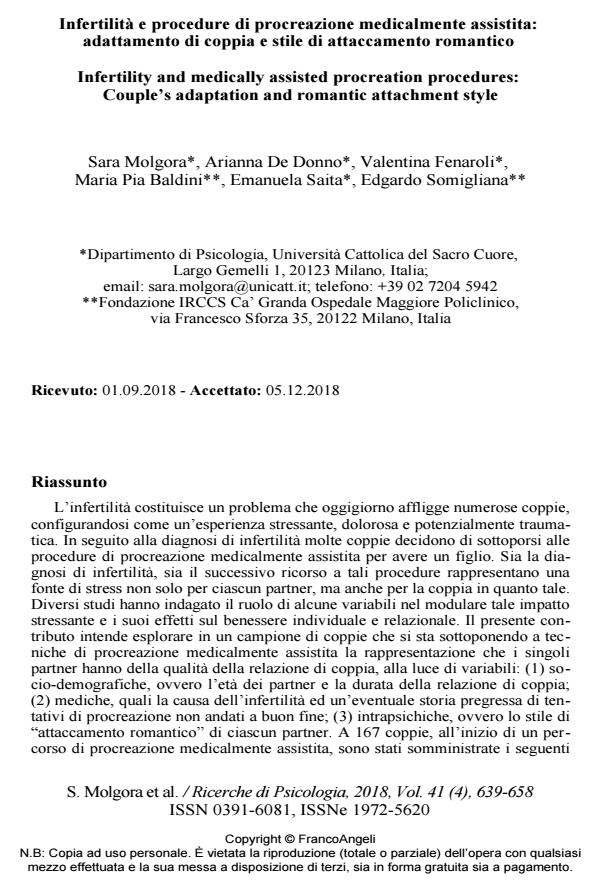Infertility and medically assisted procreation procedures: Couple’s adaptation and romantic attachment style
Journal title RICERCHE DI PSICOLOGIA
Author/s Sara Molgora, Arianna De Donno, Valentina Fenaroli, Maria Pia Baldini, Emanuela Saita, Edgardo Somigliana
Publishing Year 2019 Issue 2018/4
Language Italian Pages 20 P. 639-658 File size 205 KB
DOI 10.3280/RIP2018-004006
DOI is like a bar code for intellectual property: to have more infomation
click here
Below, you can see the article first page
If you want to buy this article in PDF format, you can do it, following the instructions to buy download credits

FrancoAngeli is member of Publishers International Linking Association, Inc (PILA), a not-for-profit association which run the CrossRef service enabling links to and from online scholarly content.
Infertility is a problem that affects many couples nowadays, representing a stressful, painful, and potentially traumatic experience. After receiving a diagno-sis of infertility, many couples decide to undergo medically assisted reproduction procedures in order to have a child. Both the infertility diagnosis and the subse-quent recourse to such procedures represent a source of stress not only for each partner, but also for the couple as such. Different studies have investigated the role of some variables in modulating the impact of this stress and its effects on individual and relational well-being. The purpose of the present contribution is to explore, in a sample of couples undergoing medically assisted reproduction tech-nologies, the representation that the individual partners have of the quality of the couple relation in light of several variables: (1) socio-demographic, i.e., the part-ners’ age and the duration of the couple relation; (2) medical, such as the cause of infertility and a possible prior history of unsuccessful attempts to conceive; (3) intrapsychic, i.e., the "romantic attachment" style of each partner. The following instruments were administered to 167 couples at the start of a course of medical-ly assisted reproductive treatments: Dyadic Adjustment Scale; Experience in Close Relationship Questionnaire; a form to collect socio-demographic data and medical information. The results indicate that neither the socio-demographic var-iables (partners’ age and relationship duration), nor the medical variables (diag-nosis, number of attempts and treatment typology) seem to have any effect on couple satisfaction, in both the samples of the women and of the men. In con-trast, a significant effect on couple adjustment emerges for abandonment anxie-ty and avoidance in the women while only an effect for avoidance on couple ad-justment emerges in the men. These results reveal gender differences connected to the specific modalities of living through and coping with the experience of in-fertility in men and women. Moreover, they shed light on how in this specific phase the couple seems to function as a container for some of the struggles that turn out to be more individual in nature, challenging clinicians and social workers regarding the type of psychological intervention that is most suitable to this deli-cate phase.
Keywords: Infertility, medically assisted reproduction, couple adjustment, ro-mantic attachment style.
- Individual and Relational Well-Being at the Start of an ART Treatment: A Focus on Partners’ Gender Differences Sara Molgora, Maria Pia Baldini, Giancarlo Tamanza, Edgardo Somigliana, Emanuela Saita, in Frontiers in Psychology 2027/2020
DOI: 10.3389/fpsyg.2020.02027 - Quality of life and infertility stress in homologous and heterologous medically assisted reproduction: The role of common and specific psychopathological traits Andrea Pozza, Davide Dèttore, Maria E. Coccia, in Perspectives in Psychiatric Care /2021 pp.717
DOI: 10.1111/ppc.12603
Sara Molgora, Arianna De Donno, Valentina Fenaroli, Maria Pia Baldini, Emanuela Saita, Edgardo Somigliana, Infertilità e procedure di procreazione medicalmente assistita: adattamento di coppia e stile di attaccamento romantico in "RICERCHE DI PSICOLOGIA " 4/2018, pp 639-658, DOI: 10.3280/RIP2018-004006